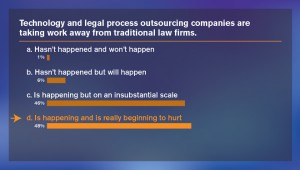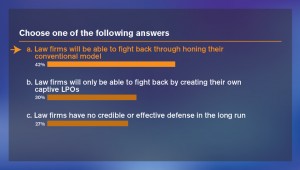For my money, the two groups voting “innovation’s not happening here” and “no investors are coming near us” (about 65% in total) have history and clarity of vision on their side. To the remaining one-third thinking we “can innovate today if [we] choose to,” I’m tempted to say: Show me, don’t tell me.
The ball is in your court.
Wow.
99.4% say that LPO’s are a force to be reckoned with, split about 50/50 between “they’re coming” and “they’re already here,” with a small tail (<6%) saying they’re not yet visible but soon will be. I don’t know who the lone respondent was predicting it will never happen, but if there’s such a thing as reincarnation I’d like to come back living in that person’s world. (Actually, I wouldn’t, but that’s a conversation for another day, with a psychiatrist in the room, not lawyers and economists.)
If I were on the LPO side of the market, I’d take this news triumphantly (“Resistance is futile”), and if I were on the BigLaw side of the market, I’d start planning my response (“Denial is futile”). Which brings us to the final question, “What’s to be done?”
Here we split 60/40. The 40% say we can “fight back [by] honing our conventional model” while 30% say we can fight back by emulating LPOs and creating our own captives, and another (nearly) 30% say we “have no credible or effective defense in the long run.”
Before I tell you what the comments reveal, let’s take the numbers at face value.





What are the attributes of the respondents to the survey (profession, role, years of professional experience, age, gender, jurisdiction)? And how many respondents responded to each question? Because this is a convenience sample with some missing data we need to know this information in order to understand the relevance of the responses.
Here’s an example of a captive LPO led by a non-lawyer: http://www.legalweek.com/legal-week/news/2254737/addleshaws-eyes-flexiworing-push-as-lowcost-base-grows-with-new-hires (in the second half of the report). Keep watching and we will see whether it is the exception. (I suspect that your point about culture may be slightly less relevant in some UK law firms, but I may be wrong.)
So much of what ails big law is a direct result of up or out. Up or out by design means that the people who handle important, expensive and very profitable assignments like large e-discovery projects are ‘promoted’ out of running those projects as soon as they have had some experience. No wonder the LPOs are eating so much of that work – they hire professionals to handle the job and keep them there. Promotion typically means more responsibility to handle the same kind of work. Thus they do and likely always will have an efficiency advantage (regardless of billing rates) because these ‘junior associate’ projects are treated as core competencies instead of training exercises.
Big law recruiting plays a key role here too. It is expensive, and as you have recently covered not very effective. High attrition coupled with expensive recruiting should indicate a real problem to be solved, it certainly does to business people who aren’t lawyers. If big law can move from its current high attrition/lots of first year hiring/up or out system to one with lower attrition/first year or lateral hiring as needed/up based on merit, out based on performance in position or business needs… much money could be saved and value provided to clients would be much improved.